Text
Blog Assignment #8

Historic Downtown Milford, Ohio is home to many local businesses to fit your shopping, dining, and entertainment needs. Nowhere along Main Street will you find a chain business. Old Milford prides itself on being completely made of local and original businesses. Just along the Little Miami River, Old Milford’s restaurants have a beautiful waterscape and have one of the biggest kayaking and canoeing routes in Ohio. This area is in the process of becoming more pedestrianized as reflected in the new DORA area which allows residents and visitors to consume alcoholic beverages outdoors while walking from business to business. Nearby apartments and residences are lucky to have this area as it provides many daily life essentials such as the Milford Public Library, Harvest Market, the Milford Counseling Center, A Million Dreams Learning Center, and the Milford Fire Department. The buildings in Old Milford are in original condition dating back to the early-middle 1900s, which adds a historical story to the buildings. Written by Reagan Sears.

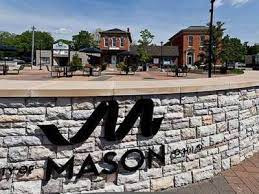
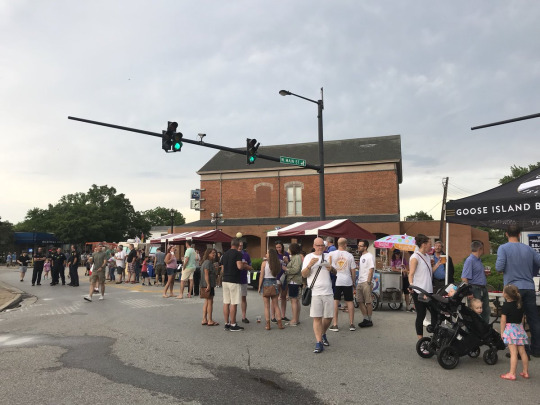
In Mason, Ohio our downtown area is a great example of Main Street. There is everything you need like restaurants, YOST (drug store), hair salons, auto shops, gas stations, a bank, etc. It is also within walking distance of the school and the municipal building so the kids and families can walk there after class, and all of the events/festivals the town holds. Since Mason is such a populated town (35,000 people), you don't always get the friendly small-town feeling. This downtown has started feeling more friendly and comfortable over the years with all of the small businesses going in. The owners fought for funding and support for the small businesses, and got it! This has improved the downtown in many ways. The shops and restaurants that have been located in Mason for years are what really draw some people to visit. For example, we have a pizza place called Two Cities that sells both flatbread and thick-crusted pizza to represent New York and Chicago styles. Their bathroom is made to look like a subway and it has won the award for the best bathroom in America in 2021! All of the buildings on this street are being used to their full potential and are very busy on the weekends. There is a gathering area with tables and seating areas to encourage socialization, along with large sidewalks that allow people to stop and chat with passing friends. This area (in the image) is also used for live music and activities that are held in this space. Mason also recently passed the DORA law which allows people to legally carry their drinks into other shops while they walk around. Written by Bella Nelson.

Bridge waterfalls are between Fairfield and Hamilton on Princeton road. A shopping center that has necessities like groceries, athletic wear, furniture, and more. The plaza has three entrances.
There is a street called Harrison Avenue that is well-connected to other neighborhoods on the west of Cincinnati, called Bridgetown and Westwood.

I lived in Cheviot where there's a thrift store called the Goodwill. It is called Camvic and it happened about 7 years ago. It depends on who you are and where you live to the point essentials will always change, but to be honest, I enjoy living in my hometown, I believe it is good. There’s a police station with camera systems, so I hardly ever felt like I was unsafe in certain areas. It is very affordable down there, and rent is not very high compared to other places. I stayed with my mom and siblings. She would lock her car and put a door alarm in our home. It is exciting to get to know your neighbors on your street so that you can all trust each other. It is honestly a comfortable lifestyle.

I also believe it is very walkable as well, the blocks are not insanely disconnected from each other and few new businesses reside. The biggest pro is that it is walkable. I see a lot of people walking with their dogs or job on the sidewalks. There always have a lot of social events that occur in the summertime, such as festivals and carnivals at Harvest Home Park. They usually have a section of Harrison Avenue, and parades are occupied at that time. Written By: Tori Walker-Gulley
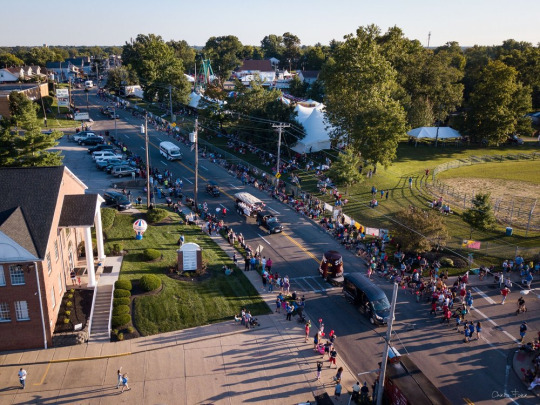
0 notes
Text
Road Diets for the Duke Energy Convention Center
Fifth St W, Cincinnati, OH 45202
Reagan Sears, Bella Nelson, Tori Walker-Gulley, Wendy Cubias
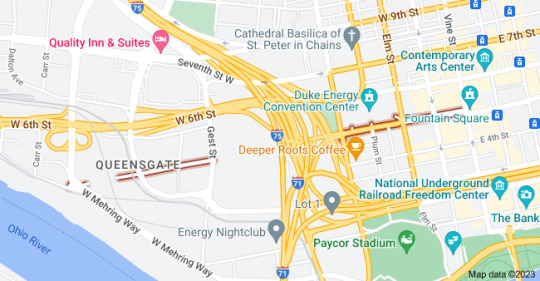




What could give the street more life?

Since the Duke Energy Convention Center is such a well known Cincinnati landmark, the exterior could be revitalized by designing murals, adding street vendors, and creating better signage and directions to the convention center.

2. Redevelopment of Fifth St W would increase business from patrons attending the popular wedding venue, The Spot. Local bars and entertainment are not within walking distance for patrons after weddings and events.
Similarly, the implementation of daytime and late-night street food businesses would succeed here from hungry business employees and late-night party-goers.

3. As seen on our map, spots 5 and 6 are vacant buildings. Because this area is full of office workers and citizens attending events at the convention center, a convenience store such as CVS is of great need to the area.

4. The Cincinnati skywalk is lifeless and blocks views of beautiful downtown. Redevelopment of the skywalk would include heightening the windows for a clearer view, designing a Cincinnati sign to make it more tolerable, or remodeling it to a floral pedestrian bridge to remove the obstructed view.


5. Street life
With the envisioned increased pedestrian usage and redeveloped nightlife, the street will need better night lighting, more modern amenities, and outdoor seating. On the sidewalks, string lights would create a more attractive view for pedestrians. The city can redevelop the outdoor area by adding flower pots and replacing the existing trash cans with dual recycle/trash cans that local artists can design. Lastly, areas for socialization require accessible seating and sheltered areas.
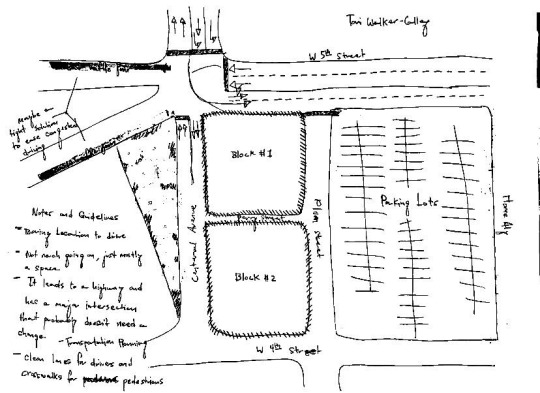
6. Poor Road Diet Sketch
The streets around this area could be significantly improved since it is in the inner city of Cincinnati. It should be a place where many people can get together and have events. Having some structurals to the streets will be refreshing since it ends on a highway and has a major intersection. We believe it is a boring location to drive and not much is going on. It just feels like a space that needs some life to it. I considered adding a bike lane, but that would be dangerous for cyclists since there's a highway of cars. At least it has some clean lanes for drivers and crosswalks for pedestrians.
0 notes
Text

3/8 Trip to W 6th Street!
Reagan Sears, Wendy Cubias, Tori Walker-Gulley, Bella Nelson
0 notes
Text
Transit Oriented Development
Barriers to TOD in America can include things like land use, zoning, funding, etc. Many cities don't have the money or knowledge to put in public transportation nor does their city want to put in the time and effort. Most transit agencies are restricted from purchasing land for TOD construction and cannot obtain the necessary land use or zoning. High populations and building densities are factors in building public transportation, but the smaller cities are left to figure transportation out on their own. An example of a city with no public transportation is Broken Arrow, Oklahoma. Written by Bella Nelson.
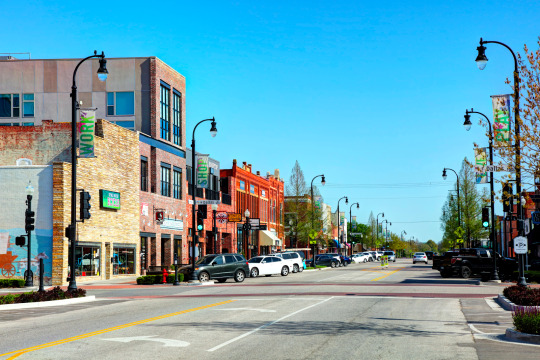

An example of successful TOD exists in Stockholm Loop, Sweden. Here, there are 120,000 homes built or in the process of being built in 12 underutilized locations at the outer edges of the Stockholm metro system. High-density areas are not only used to accommodate housing, the Stockholm Loop provides commercial use, office spaces, business, and sports attractions. More condensed housing provides increased and better connectivity to the Stockholm Metro System. As pictured, the heart of the Stockholm Metro system is still pedestrian friendly and has a high-density working space. Areas around the Stockholm Metro system are made attractive during more hours of the day. You can see the natural green workspace in the office building above. The Stockholm Loop is revitalizing sports life in Sweden with an annual triathlon.
Written by Reagan Sears.
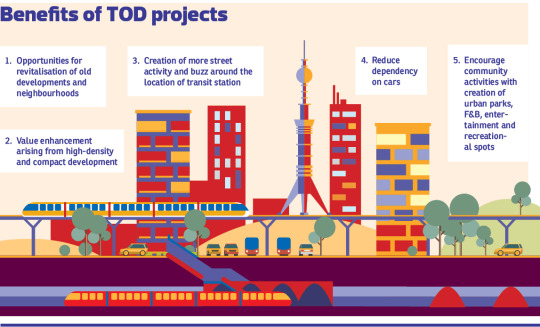
Los Angeles, Dallas, New York, and other cities with a lot of people had trouble because roads took over a lot of public and friendly spaces. The increase in traffic hurts public events that used to fill the streets, like markets, parades, getting to know your community and other social events. These places have slowly been taken over by cars and trucks in America. How traffic moves now affect how people live, interact, and use the streets in a city. People are less likely to get together to do things on the road again because there are so many cars. This makes people less possible to walk or ride bikes as other ways to get around. For this to work better, a community could start a big fund or give a lot of money to make projects more open and friendly again for social gatherings and not always crowded.

Source - https://www.archdaily.com/992621/multi-use-public-spaces-and-urban-design-copenhagen-and-social-integration
Copenhagen is an excellent example of a city with a great infrastructure and a way to get around by bike. In Denmark, people ride bikes more than they drive cars or use roads. People can get to know each other and the city well in a public space as in the example above. Written by Tori Walker-Gulley.
The Republic of Singapore is a small island with so much life in the city. Singapore has a mass rapid transit and bus system all around the city, 6 MRT lines that have more than 130 stations for easier access. Because of trains and buses there’s less accidents that can accrue. Families that may struggle with money can make it easier for them to get to work or somewhere else. People can socialize more whether in the stores, hot spots, or even in the transportation.
Written by Wendy cubias


0 notes
Text
Food Insecurity
What are possible ways of alleviating food insecurity problems in the Cincinnati area (including UC campus)? Support your answers with visual examples.
Almost everyone in Cincinnati, especially near campus, has a gas station close enough for them to walk to. Since gas stations typically only sell imperishable foods such as dried, processed, and tinned products, they all lack nutrients and vitamins. The people who walk to a gas station to get their food aren't eating as healthy as people who have access to grocery stores because there are much less choices. By providing these gas stations with healthier options such as fresh fruits, vegetables, pre-prepared healthy meals, and even pamphlets on how to eat better, this would help these families tremendously. Giving these gas stations funds to bring in much better options will help the city as a whole to get out of food insecurity situations.
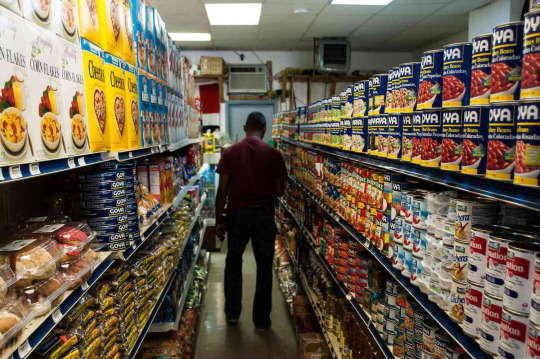
Written by Bella Nelson.
One of the biggest problems we noticed when coming to college is noticing the amount of waste we produced in the dining halls and in our dorms. An abundant amount of food is thrown away in the dining halls because people overfill their plates with the buffet-style option. Aside from encouraging students to be more cautious with their portions, the dining halls should implement a composting system to create a greener solution to food waste. Compost minimizes the amount of greenhouse gases released into the atmosphere, strengthens soil quality, and reduces soil erosion. The soil created from composting can then be used to create a community garden to provide more healthy options to college students. Produce and perishable items may be hard to buy in small quantities, therefore, many students face food waste problems when they’re buying groceries and eating for 1. One way we can combat food waste in residence halls is by providing community fridges, for students to take what they need and leave what they can.
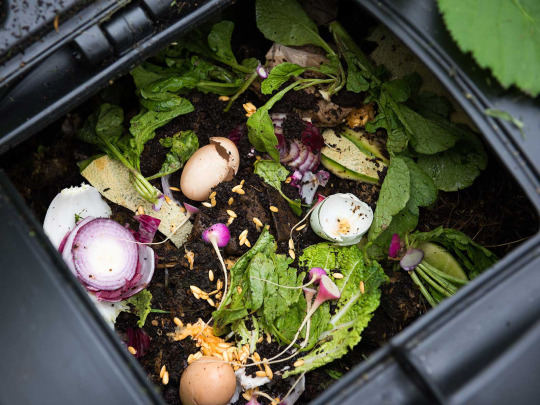
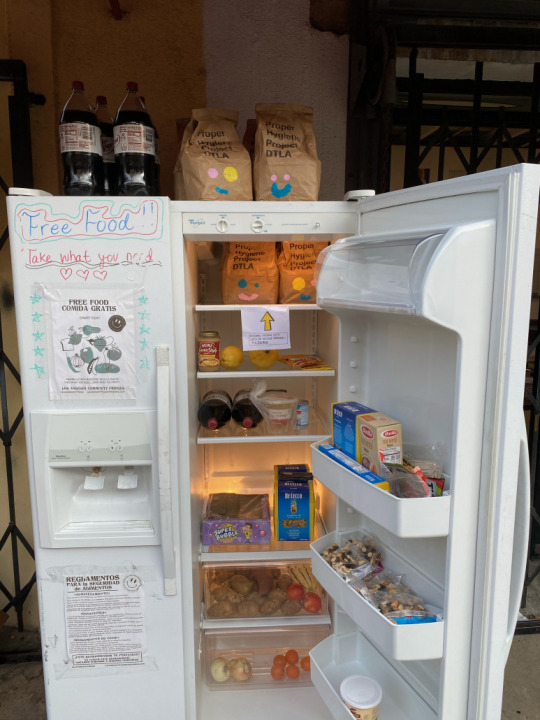
Written by Reagan Sears.
The lack of traditional grocery stores with large selections of fresh food in neighborhoods with high poverty rates is certainly a barrier to those residents accessing fresh food. But the bigger and more immediate problem is the cost of going to the grocery store, and the cost (in time and money), of buying and preparing healthy food. Since the Healthy Food Financing Initiative (HFFI, which provided funds and tax breaks for opening grocery stores in underserved areas) was enacted in 2010, research has shown that families in areas where a grocery was added didn’t change their buying habits that much, and that people sometimes even traveled further to get cheaper food, or kept buying at dollar stores that provided fresh food if there were any near them. Research has also shown that people in wealthier neighborhoods often travel similar distances by car to get groceries as people in poor neighborhoods.
So it seems that the problem is more the fact that people are in poverty, and a comprehensive solution is needed to reduce financial stress on people in poverty and/or with lower incomes. Some places to begin, which apply anywhere, but could be implemented in Cincinnati, would be increasing the minimum wage to a living wage, maybe creating a system through which people can get subsidies specifically for car payments and other things to help build their credit, and expand who can get rent subsidies, as well as make them available in any rental. It would also be useful to expand who qualifies to use SNAP, and in the longer term design public transportation to make it quick and cheap to reach grocery stores from low income neighborhoods and carry groceries back home.
HEALTHAFFAIRS.ORG
PJ Schomaeker
Hunger and other forms of food insecurity affect the majority of Cincinnati residents in simple ways. Having a mentality of thinking about how college students and locals can get enough food People who are passionate about this societal issue should want to help send things to the university or other nonprofit organizations such as food, clothes, and toiletries, which is why the Bearcat Pantry exists on campus so that college students who struggle with money or don’t have enough can have access to these necessities.
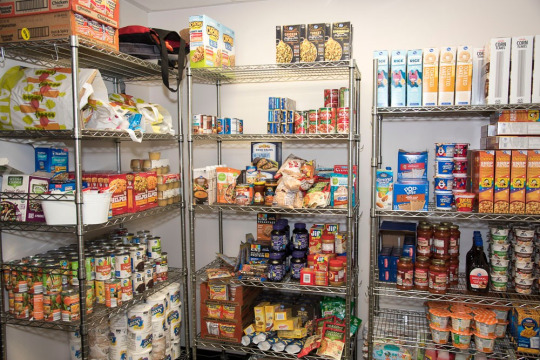
Outside of campus, many locals who live in low-income, underserved neighborhoods struggle with food insecurity. It will be a complicated problem to think about how to give free food to those who are struggling to live without making them too dependent on free food. We believe that the best way to assist the city of Cincinnati is to raise funds to help them build their local infrastructure. However, this effort needs to be very well coordinated so that the two essentials do not hurt each other, and there is a central authority that can get involved. Written by Tori Walker-Gulley
0 notes
Text
The Future of Transporation
If Cincinnati created more efficient bike paths, I think the growth of bike share would be useful. A big problem with this is how hilly Cincinnati is in some parts, but there is an electric bike-share option that would work much better. There are motorized scooters called "birds" that are all around, but you could not use these to go far distances because you have to stand. When using these bikes, they would be intended for longer distances, so it would be ideal if it was a bike with a basket to hold your things. Though these would be more expensive than regular bikes, they would be used much more often, and more money would be made. Another problem I thought of was the process of renting the bike. Most of the scooters and bikes are rented from an app, which is very helpful, but if there was a screen on the bike where you could swipe a card, this would expand the chance of more people renting the bike. If there was just an app, some may not even try it because it's too much work, which I have done before. Written by Bella Nelson
Another measure the city could take to make the already established bike paths and more walkable neighborhoods easier for citizens to use would be creating cable car routes on the major hills surrounding downtown.
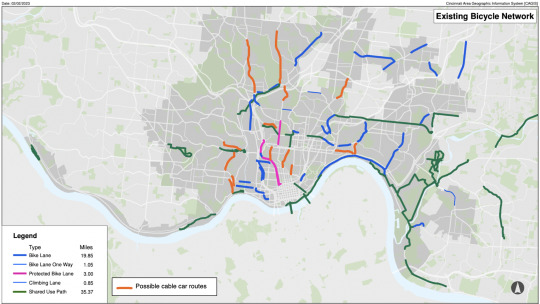
Even a few cable cars connecting business districts, like connecting the protected bike lane along Clifton Ave with the one along Central Pkwy would vastly reduce the time and effort required to bike or walk between areas like Clifton, CUF, and inner Cincinnati. Removing the impact of the hills would increase access to the city for people without cars, and make modes of active transportation more accessible. It would be ideal to build the network of cable cars to serve the wider radius of residential neighborhoods on Cincinnati’s surrounding hills, so that there is equitable access to bike and pedestrian infrastructure, even in neighborhoods with less profitable or non-existent business districts. The routes would also better connect the residential areas of outer Cincinnati, lessen their isolation from the city center, and lessen the entire city’s reliance on cars. PJ Schomaeker

Cincinnati already has an operating streetcar known as “The Connector,” which includes five streetcars and travels a 3.6-mile loop connecting the city's riverfront at The Banks, Downtown, and Over-the-Rhine. This “no-fare” option is a fantastic addition to the city and needs to be expanded to more local areas. The streetcar is a clear attraction to locals and tourists and stops at popular destinations such as Findlay Market, Washington Park, The Banks, and Fountain Square. The benefits of the streetcar include being fully accessible to people with disabilities, reducing vehicle traffic, creating a safer option for pedestrians, and making the city's attractions more accessible. I think that by expanding the street car to the Bellevue and CUF neighborhoods, we would decrease crime rates and encourage more travel to and from OTR, Bellevue, Clifton, and more. One way we can keep the streetcar free for passengers is by wrapping the streetcar in advertisements that businesses pay for, as seen below. Written by Reagan Sears
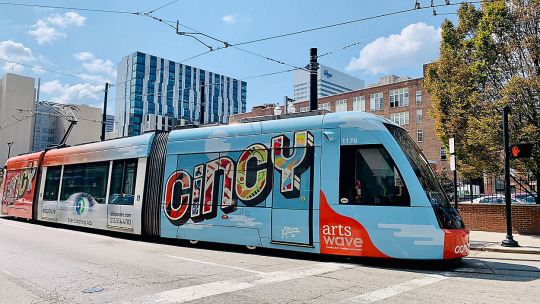
The solution will come when a more significant number of people campaign for and support the one we currently have, and encourage elected officials to extend and strengthen it. The idea of reinventing Metro has a good chance of being implemented successfully; however, this can only happen if the political leaders really provide the two lines of BRT with the right-of-way necessary for their operation to be effective and promote density along the routes that are selected. Any of the many ideas in this article, like increasing the frequency of service, the streets themselves, the signs, and the many other parts of the system will only be put into action if there is enough political pressure and ridership to justify making big changes. Written by Tori Walker-Gulley

The type of transportations needed in Cincinnati are light rail and bike share. Cincinnati has many business and attractions, a majority of the people working or living there walk. Cincinnati main transportation is having a car, a bus, or the subway, but two transportation can take us so far. Having a car we can get stuck in traffic and a subway goes in a big circle and can’t transport people in the middle of the city or outer parts. Having a light rail can go all over the city, less traffic and decrease accidents. Having bikes on the road instead of cars can minimize pollution, accidents, socializing more with others and exercise through the day. Wendy Cubias
0 notes
Text
Density or Sprawl?
Denver, Colorado is a highly populated area and it will continue to grow. I looked it up on google maps and found a golf course, park, and lake that are all connected in the same large area. This stuck out to me because all of the streets around it are smaller, rectangular blocks with housing. This is the ideal setup because it makes it easier to get places when you can go within the streets instead of all the way around large blocks. Around this area they have plenty to do within walking distance, this is one factor that will keep people coming to Denver. To get to your home there are alleyways, which help with traffic by splitting it up. Written By Bella Nelson.
In my opinion, townhomes hold the best density for city designs today because they value community amenities and still provide individualized homes to families. Front-facing, walkable streets are important to me, and the narrow designs of townhomes provide the opportunity to walk to the nearest homes and buildings. The townhome project that sticks out the most to me in Cincinnati exists in the East End neighborhood on Riverside Drive. With plans to expand, the Riverside Drive townhome project beautifully exhibits the urban design of townhomes and proves that you do not have to sacrifice privacy or a yard to live in a townhome design. The townhomes shown provide roughly 15 housing units per acre, so they are slightly more compact than single-family cluster housing, but maintain their square footage through the 2-3 story design. Written By Reagan Sears


Over the Rhine is about the densest neighborhood in Cincinnati, because it was originally built as both an entertainment and housing district during the 19th century (before the Incline was built and development of the hills of Cincinnati wasn’t really possible yet, so the density of the inner city was high). Its population and the communities it houses have fluctuated greatly throughout history, but its built fabric has largely remained intact despite slow, continuous decay and demolitions. OTR is characterized by rows of connected or closely spaced, 2-4 story town houses (many of which have storefronts in the first story), relatively thin streets, and alleyways within blocks.


This block, between Pleasant, W Liberty, Green, and Race St, measures about 1.5 acres. Based on the street view, I estimate there are about 159 housing units on the block, making its density 106 units/acre. The FAR is somewhere around 3.5 to 1 for the entire block, since most of the buildings are 4 stories, some with 3 or with a half-4th story, and there are a couple vacant grass lots or yards. This is very dense, but it can be sustainable if the blocks are small with useful walking space between them, if car traffic through them is minimized, and there is a correspondingly large amount of green space and other public community space near them. Having greenery along roads and walkways also makes dense blocks like this much more liveable. Written by PJ Schomaeker

The best density design for a city would be about 16,000 people per square kilometer, which is about what Barcelona has. The city has great public transportation, so the roads are narrower and there are fewer cars, locals, and parking lots. There are no highways or expressways cutting through the city, and there are a lot of public spaces, parks, lively street life, and more. And yet, even though the population density is the same as in downtown Toronto, most of the buildings are small and there are not many skyscrapers to be seen. Written By Tori Walker-Gulley

Source - Porada, Eugeniusz & Szyszkowicz, Mieczysław. (2016). UNMIX Methods Applied to Characterize Sources of Volatile Organic Compounds in Toronto, Ontario.
A lot of the bad things a planner said about cities are not necessarily because they have more people, but because they have more cars. If Toronto suddenly had the same transportation system as, say, London or Paris, and a lot fewer people drove, the roads would be narrower to give people more space to walk, parking lots would be turned into public squares (or built up), and there would be a lot less pollution in the air, among other things. The problem isn't more people living together, but more cars. Written By Tori Walker-Gulley
0 notes
Text
Lessons from Haussmann and Burnham
Some ideas that Haussmann put into his architecture plans spilled over into Chicago's plans as well and I believe some of them would work well in Cincinnati. Since both Paris and Chicago are very highly populated they figured out new transportation methods like underground trains to keep the streets more clear. This could benefit Cincinnati because then most transportation could move underground which would lessen the amount of accidents on the streets. This could also benefit us because it may draw people to the trains instead of driving to their destination which could help pollution, traffic, and gas prices. Bella Nelson
Moving public transport underground could be even more feasible for Cincinnati than many cities, because partial subway tunnels have already been constructed (during the early 1900s) beneath it. They are sealed off and in disrepair, but this infrastructure could be a starting point for revisiting the project, at least to create routes connecting the neighborhoods downtown and closely surrounding it.


(planned and built extent of Cincinnati subway tunnels)
Both Haussmann and Burnham emphasized the importance of public parks and gathering places, and Cincinnati has room to grow in these respects as well. It is already closer to Haussmann’s ideal of every residence being within 10 minutes walk of a park than most cities in the U.S., with about 88% of people in city limits living within walking distance of a green space. But certain neighborhoods, like Lower Price Hill, Camp Washington, and the core of Downtown, have disproportionately less access to public green space, and less tree cover. POC and people in low income neighborhoods also have considerably smaller park space near them than white and wealthy people. (https://www.cincinnati-oh.gov/cincyparks/news/cincinnati-once-again-ranked-top-10-city-in-the-nation-for-parks/parks-overall-trust-for-public-land-score-2022/).
Moving some commuters underground could free up space for adding foot and bike paths along roads that currently lack them, as well as expanding and creating new green space. Even planting trees or gardens along roadways would improve air quality, cool those areas during hot months, and improve storm drainage. Removing some of the demand for vehicle space could allow for this in some places without as extensive building/infrastructure demolition as Paris and Chicago underwent.

(Lick Run Greenway recently built along Queen City Ave in Fairmount) PJ Schomaeker
Haussmann’s plans of Chicago incorporated large bodies of water into transportation, entertainment, and attraction. The City of Chicago’s riverwalk has become a recreational spot for locals and tourists to congregate over unique restaurants, views, and events. In Cincinnati, I believe urban planners have done an excellent job in developing a multi use riverwalk along the area of Smale Park. Although the Kentucky side of the Ohio river has beautiful spots and attractions, there is more room for Haussmann’s plans to be developed.


Less than 1,000ft across the river from Smale Park, you will find Covington Plaza, a recent project designed to connect the city of Covington to the river. This alluring addition to the city is missing the 24/7 attraction that the Chicago Riverwalk holds. Covington Plaza meets the recreation aspect of Haussmann’s “Transportation, Recreation, and Economy” idea. But there is no steady income happening at the plaza unless an event is happening. Covington Plaza could further their design with tables and chairs along the plaza, that patrons could use to grab food from food trucks or restaurants along the street. Additionally, Covington Plaza could feature boat tours along the Ohio River, especially in summer months that could share information about the unique events and parks along the river. Reagan Sears
A lesson Cincinnati can emulate from Paris is destroying infected, unwanted alleyways, and from Chicago, improving their waterfronts. A week ago, I walked around Corryville and Mount Auburn with my assigned group for studio class. We found a lot of alleys in Corryville that were almost forgotten and had decomposing cracks from the buildings that made the path very narrow. The closed-off air was polluted with stale cigarettes and oil. I believe Cincinnati can do better with the alleyways to make those unwanted spaces more accessible. The waterfronts in Cincinnati are polluted with waste and dirty water. If Haussmann and Burnham were around, I honestly do not believe they would approve of this. It will catch up to the residents if there isn’t a solution. Tori Walker-Gulley
0 notes
Text
The Ideal City
My "ideal city" values residents. Blue whale refuges are unknown to me. Please tell me about excellent urban environments for people. Not only a workplace, but a city can also help individuals attain their full potential. Stores, schools, and jobs must provide inhabitants with basic needs. Urban planning prioritizes nature and mobility. It's walkable and has excellent public transit. Smaller parks, plazas, and retail lanes replace shopping malls. covered roadways. Walkable routes and bike trails cross the grid. I prefer broadacre city and garden utopias. Howard and Wright inspired these concepts. Some people, particularly families that want to raise their kids near a park, reside on the park's limits because they enjoy parks. Parks are lovely places to stroll, but blocking them goes against the idea that nature gives cities vitality. Urbanites operate better in crowds than ruralites. Planning a place should prioritize individuals. Tori Walker-Gulley
An ideal city is one in which all citizens have equitable access to living necessities like clean water, healthy food, health care, green space and other community gathering places, natural light, suitable work, entertainment, and even general safety in the city. Living sectors would share space with the rest of the functions mentioned when possible (e.g. apartments on top of shops or entertainment, or with green space on their roofs and/or between them). The city would also have as little negative impact on the surrounding environment as possible, be as resilient in its unique environment as possible, and incorporate some agriculture, (or at least extensive plant life), throughout city limits.
Equitable access to all parts of a city requires accessible public transport routes around the city, and between it and other cities and resources. Communal transport by train and bus would ideally be supplemented by bike and walking routes, and all routes needed to reach train and bus lines would always be walkable and accessible as well. An ideal city would have public transport infrastructure thorough and effective enough to eliminate the use of cars, which would be prohibited within the city. The absence of cars would minimize noise and physical pollution, physical and mental danger and stress, and transportation congestion.
No existing cities meet all, or even most, of these criteria, but many incorporate some of these goals into their development. Written by PJ Schomaeker
Going off the idea that an ideal city provides equitable access of living necessities to its residents, a few examples come to mind. An excellent project that I think should be replicated in other U.S. states was completed by The Kansas Department of Health and Environment. In 2014, over 60% of Kansas adults were classified as overweight. KDHE’s initiative to battle this statistic was to formulate city plans that included more access to sidewalks and bike paths in local communities. The new plans encouraged pedestrian activity for mental and physical health benefits. The accessibility of the newly updated Kansas neighborhoods reminds me of Howard’s “Garden City” In Garden City, there is a lot of greenspace for exploring, and streets are divided frequently enough for walking access throughout the neighborhoods. Reagan Sears
Another great example of an ideal city is Kadoorie Hill in Hong Kong. Kadoorie Hill provides an environmentally friendly landscape while offering residents a variety of housing options to suit everyone's needs. There are 85 houses and 39 apartments within a 30-acre land which is as big as 22 football fields. The neighborhood nearby, which is a heavily populated area, can still be green. The Kadoorie Hill is an inspiration to Hong Kong and to future planners wanting to bring nature back into the city. Wendy Cubias
An ideal city for me was the garden city structure. It is perfect for people who want to live in a “green area” but also experience city life by having everything they need near them. You still get the neighborhood set up for families and to make friends, there is also a school, hospital, grocery store, and everything else you may need in your everyday life. Living in nature is becoming more popular, and this setup makes that possible. You can also find garden cities within bigger cities like YellowSpring and Oxford Ohio. Bella Nelson
1 note
·
View note